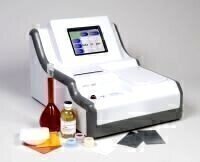Environmental laboratory
At-line Analysis for the Metal Industry
Jan 01 2000
SPECTRO has developed a new application for the metal industry for at-line measurement of hydro-silicon, phosphorous, zirconium, titanium, vanadium and chromium coatings using a robust XRF instrument. The detection limit for phosphating, for example, is only 13 g/m². SPECTRO documents the new application in an application report that describes the measurement arrangement and results from several test series. The report is available free-of-charge Clich here
Until several years ago, chromating was nearly the only conversion coating used. However, due to the harmfulness of hexavalent chromium and the restrictions placed on its use within the framework of the RoHS directive, manufacturers now work with coatings that are more environmentally friendly. Trivalent or tetravalent chromium, hydrosilicon, phosphorous, zirconium, titanium or vanadium is now used, depending on the material properties required from the coated metal.
All of these coatings reliably protect steel and aluminum from oxidation and function as bonding agents – provided that the coating is uniformly applied and is neither too thick nor too thin. To optimize quality while minimizing costs, the coating must be controlled regularly during the production process. To achieve best results, SPECTRO offers the SPECTRO PHOENIX II; a stable all-round instrument that can be consistently and easily operated even in the harsh production environments found within the metal industry
The new application report documents six test series with the PHOENIX II: chromium, titanium and zirconium coatings on aluminum, chromium and phosphorous coatings on steel and hydrosilicon coating on chromated steel. The instrument delivered extremely reliable results in all of the tests. The deviations were clearly below one percent of the application weight.
In a typical application, an employee cuts several seven by ten centimeter samples from the steel or aluminum. The samples are then placed in succession with the coated layer down into the SPECTRO PHOENIX II sample chamber. The employee starts the measurement on the intuitive touch screen and receives the exact measurement results within several minutes.
SPECTRO PHOENIX II reaches its limits for applications in which the spectral lines for the coating and the carrier are very close together. An example of this is thin chromating on steel sheets. For these types of applications, SPECTRO offers the SPECTRO XEPOS high-end XRF instrument that utilizes a higher spectral resolution than the PHOENIX II and also can reliably distinguish between spectral lines that lie close together.
Digital Edition
IET 35.2 March
April 2025
Air Monitoring - Probe Sampling in Hazardous Areas Under Extreme Conditions - New, Game-Changing Sensor for Methane Emissions - Blue Sky Thinking: a 50-year Retrospective on Technological Prog...
View all digital editions
Events
May 06 2025 Nuremberg, Germany
May 10 2025 Karachi, Pakistan
May 11 2025 Vienna, Austria
May 11 2025 Seoul, South Korea
Salon Analyse Industrielle & Instrumentation
May 14 2025 Paris, France






.jpg)


_(4427399123)-(2).jpg)









